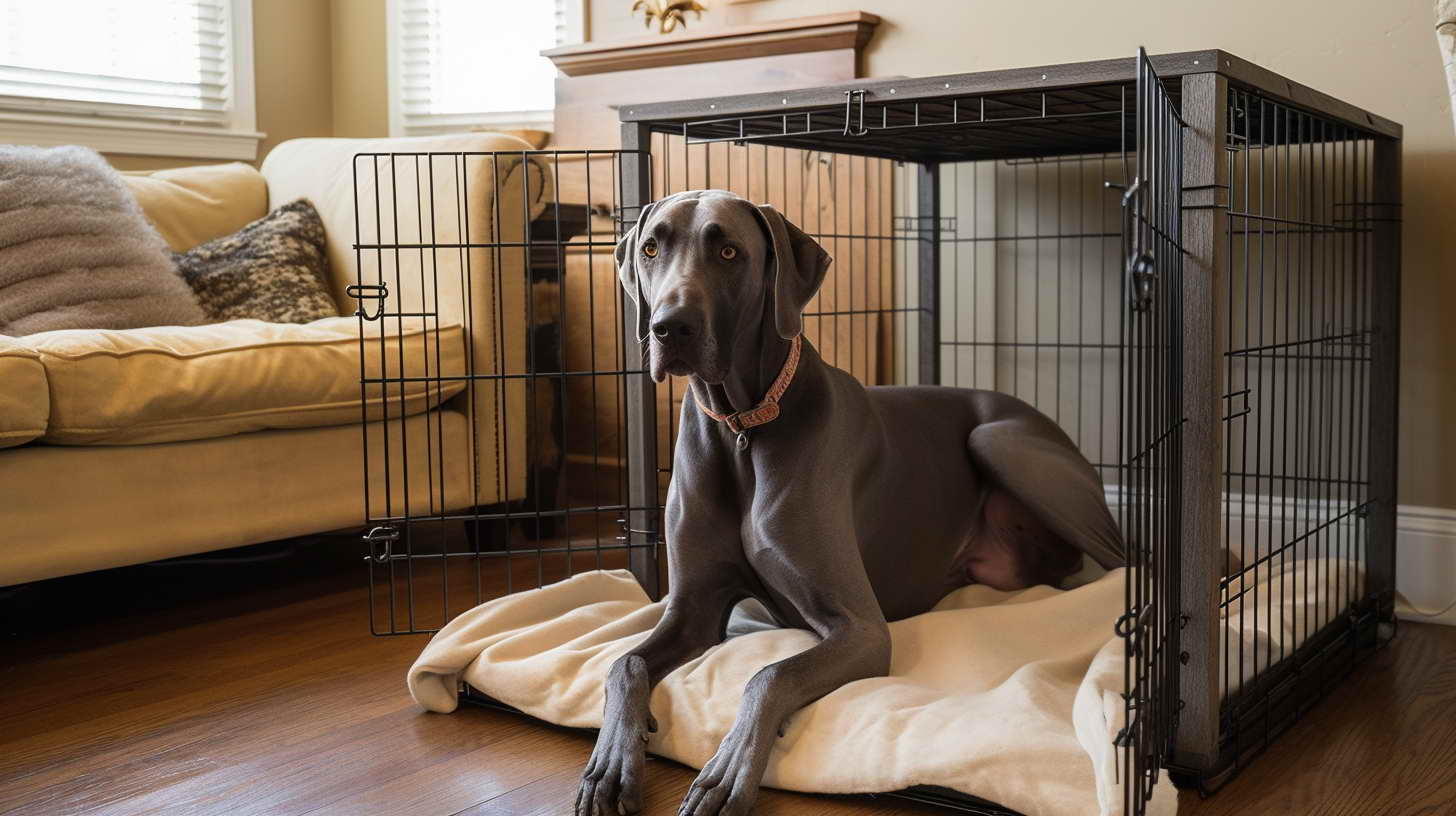
Crate Size For Great Dane
PETSIDI – The Great Dane is a massive dog breed that can grow to be over 30 inches tall and weigh up to 200 pounds. Due to their large size and rapid growth rate, choosing an appropriately sized crate for a Great Dane is extremely important for their health, safety, and comfort. This article will examine the ideal crate dimensions, sizing guidelines, and ** containment solutions** to ensure your Great Dane has a spacious, comfortable crate that will accommodate them as a growing puppy and fully grown adult dog.
Kennel Size Recommendations For Great Danes
Most experts recommend choosing a crate for your Great Dane that allows them to fully stand up, turn around, and lie down comfortably inside. For most adult Danes, this means selecting a crate that is a minimum of 42 inches long, 28 inches wide, and 32 inches high. However, crate dimensions can vary based on your individual dog’s size, weight, and proportions.
The chart below provides general crate sizing guidelines for Great Danes:
| Great Dane Weight | Recommended Crate Size |
|---|---|
| 90-110 lbs | 42L x 28W x 32H inches |
| 110-130 lbs | 48L x 30W x 33H inches |
| 130-150 lbs | 54L x 32W x 35H inches |
| 150-200 lbs | 60L x 36W x 38H inches |
However, you’ll also want to consider your Great Dane’s height and body length when selecting a crate, not just their weight. The kennel should be long enough for them to fully stretch out, but not so large that they can potty at one end and sleep at the other.
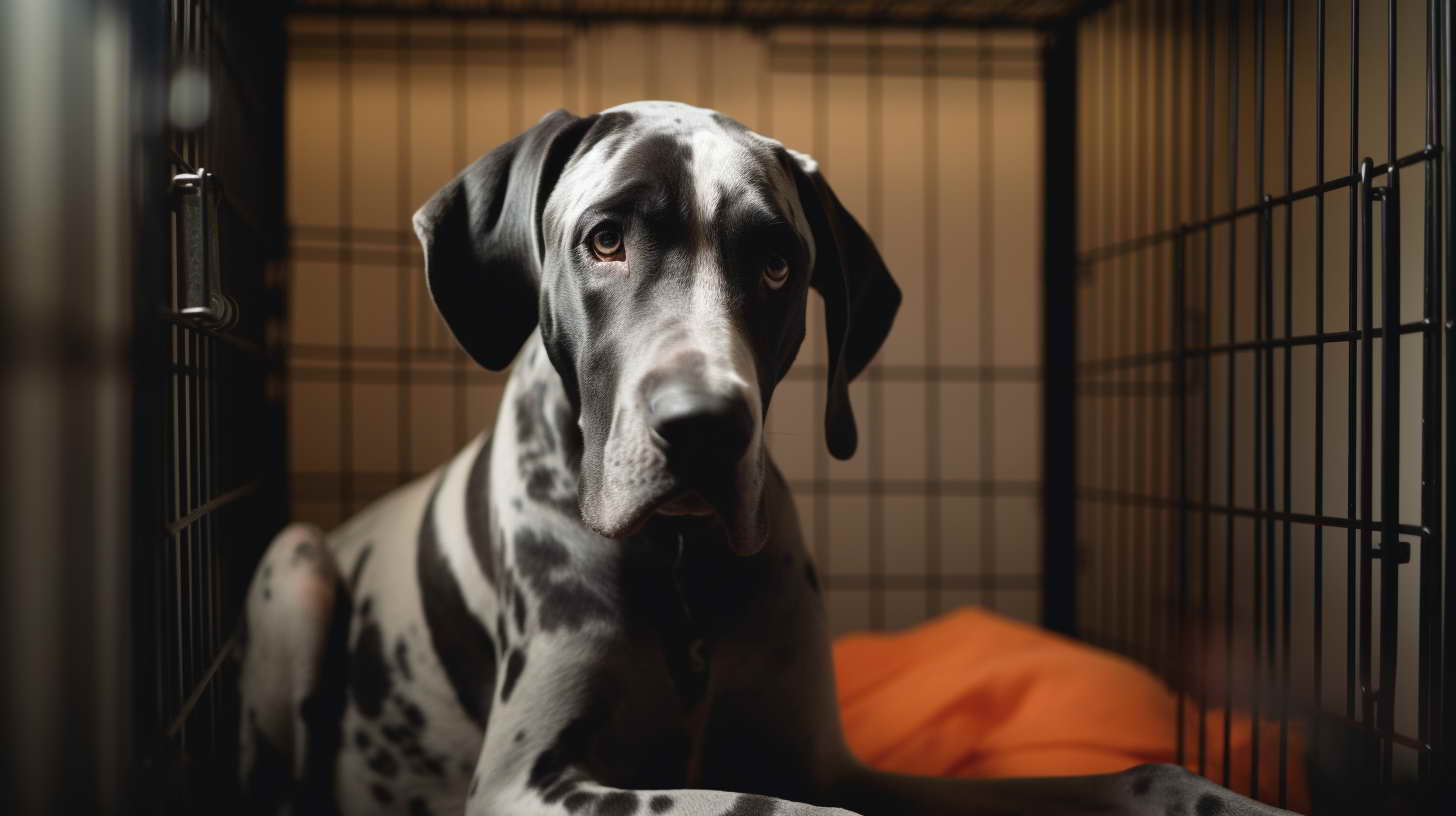
Oversized and XXL Crates For Great Danes
Due to their massive size, most standard crate sizes are too small for adult Great Danes. Instead, you’ll need to look for oversized, extra-large, or XXL crates designed for giant breeds. Some good options include:
- MidWest Solutions Series “Ginormus” Double Door Dog Crate – available in 42, 48, 54, and 60-inch sizes.
- Precision Pet ProValu “Giant” Double Door Dog Crate – available in 50, 54, and 60-inch sizes.
- Petmate “Ultra Vari” Double Door Kennel – available in 48, 54, and 60-inch sizes.
- Lucky Dog “Sliding Glass” XXL Dog Crate – available in 60 and 72-inch sizes.
- Petnation “Port-A-Crate” EZ Modular Kennel – can expand up to 80 x 40 inches.
Look for heavy-duty crates designed specifically for giant breeds that utilize thick wire gauges, reinforced panels, and industrial-strength latches to contain destructive oversized dogs. We recommend checking on Amazon for pricing and comparison.
Selecting The Proper Kennel Size For Great Dane Puppies
Great Dane puppies grow incredibly fast, gaining up to 10 pounds per week. You’ll need to size up their crate multiple times before they reach adulthood. Start with a crate just large enough for them to stand up, lie down, and turn around. Then transition to a larger size every time they go through a major growth spurt.
Some sizing guidelines as your Great Dane puppy grows:
- 8-12 Weeks: 30L x 22W x 24H in
- 3-6 Months: 36L x 24W x 28H in
- 6-12 Months: 42L x 28W x 32H in
- Full Grown: 48-60L x 30-36W x 33-38H in
Purchase a crate with dividing panels or partitions so you can limit the space while potty training, then adjust the internal size as your puppy grows. Monitor your Great Dane’s measurements weekly and transition to a larger crate size whenever they appear cramped.
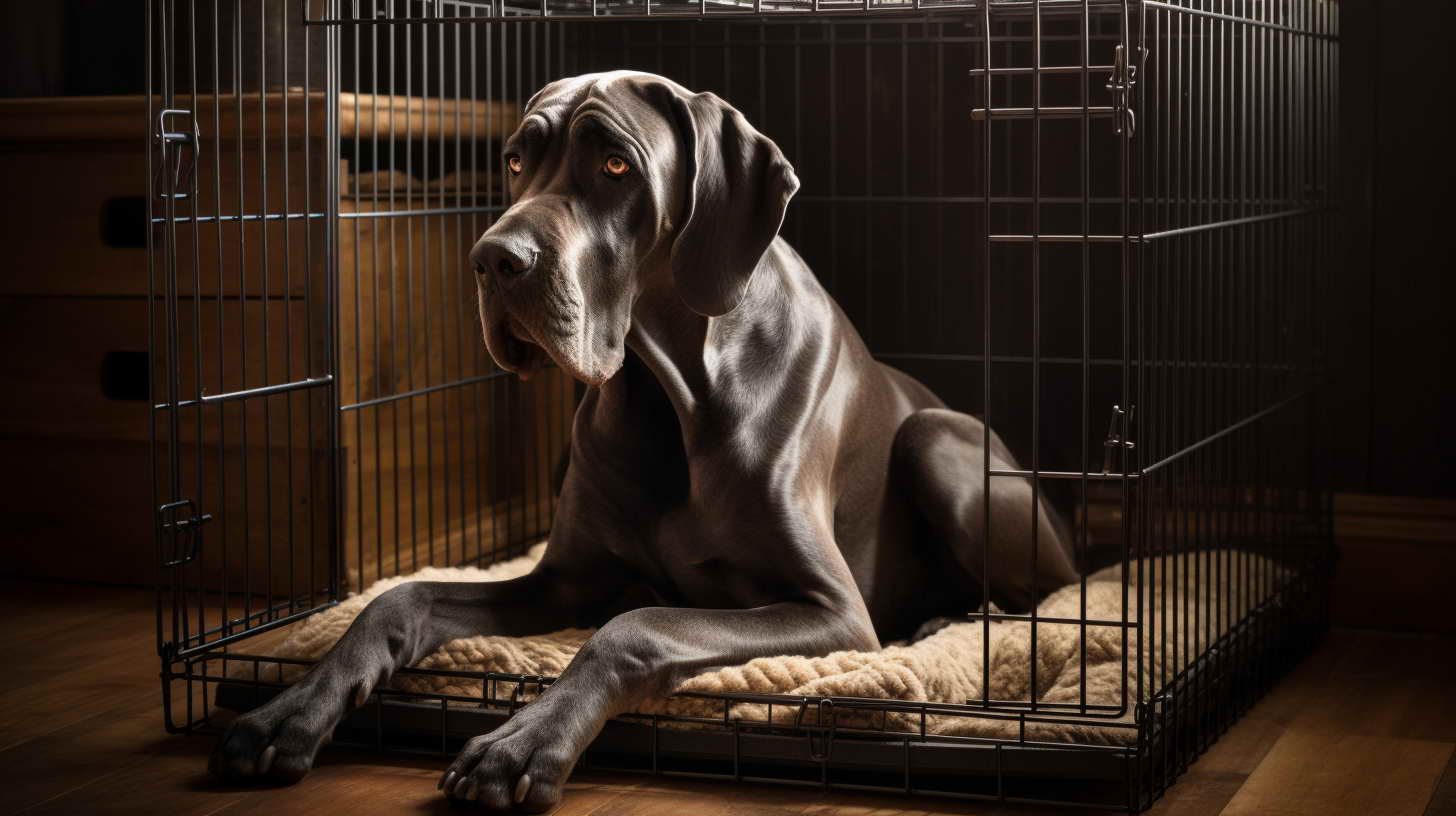
Tips For Selecting The Optimal Great Dane Kennel
Follow these tips to choose a properly sized crate for your Great Dane:
- Measure your dog from nose to tail while they are standing, sitting, and lying down.
- Select a kennel that is 4-6 inches longer than its standing length.
- Make sure they can sit and stand fully upright without their head touching the ceiling.
- Look for crates with multiple-size configurations or moveable divider panels.
- Get a crate that is only wide enough for them to lay completely on their side.
- Doors should be large enough for easy entrance and exit.
- Be prepared to purchase multiple crates as your puppy grows.
- Focus on heavy-duty crates designed for giant dog breeds.
Choosing the right-sized crate is essential for ensuring your Great Dane has enough living space and won’t feel cramped or distressed. Take precise measurements and opt for an oversized kennel to accommodate their growth.
Crate Training Considerations For Giant Breed Dogs
Crate training a Great Dane puppy takes patience and proper techniques due to their large size. Here are some tips for effectively crate-training giant breeds:
- Introduce the crate slowly and make it a positive space with treats and praise.
- Ensure the crate is placed in a low-traffic area of your home.
- Stick to a regular feeding and potty schedule.
- Use divider panels to limit usable crate space when potty training.
- Remove collars, leashes, and harnesses that could catch on the crate.
- Provide safe, durable chew toys to entertain them.
- Start with brief, separated periods in the crate and work up to longer durations.
- Reward calm behavior and never use the crate for punishment.
- Avoid confining for more than 4-6 hours at a time.
Proper crate training sets the foundation for your Great Dane to see their kennel as a safe space rather than a confinement.
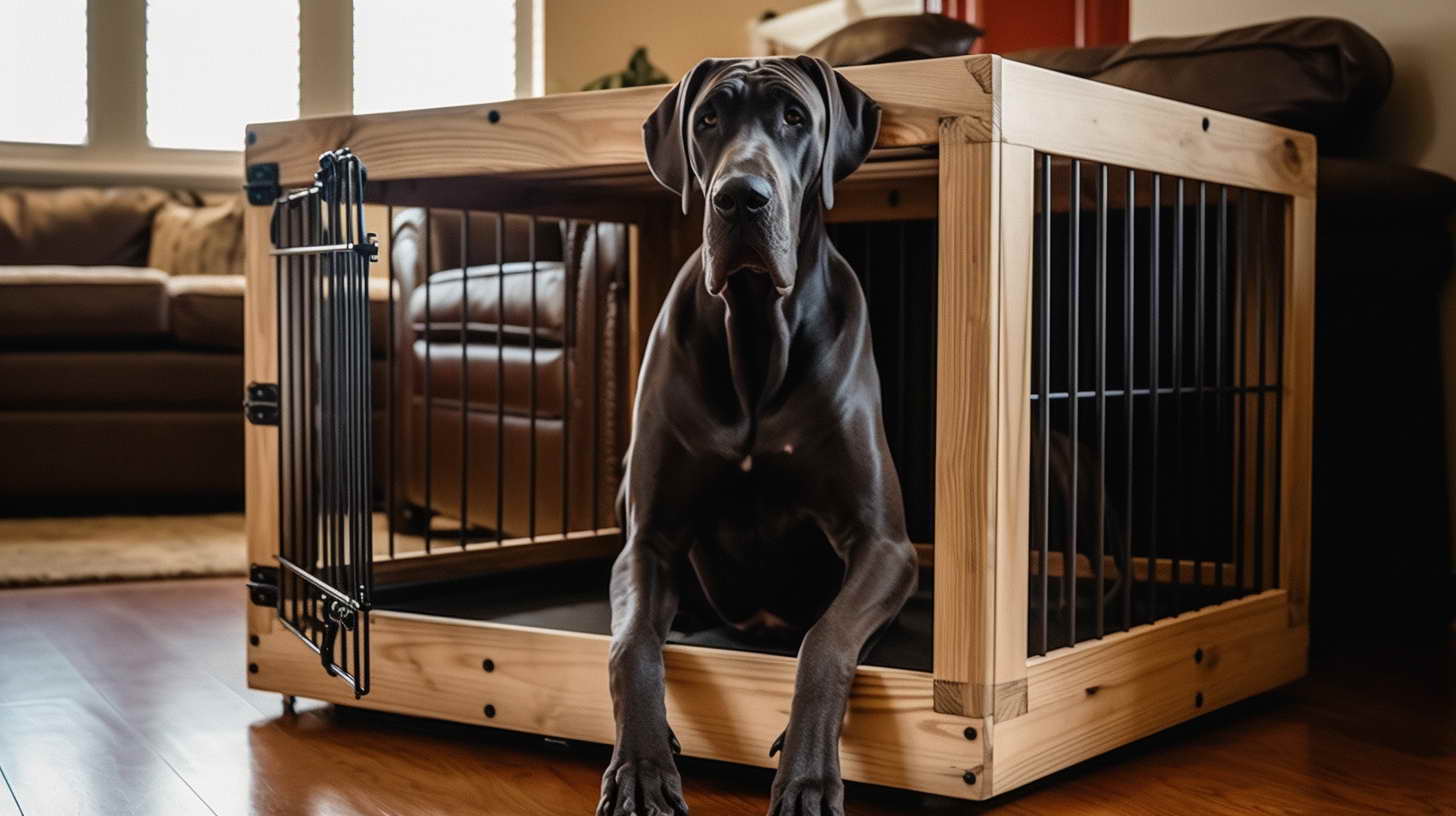
House-Training Oversized Puppies In A Crate
Crate training is extremely helpful for house-training Great Dane puppies. By nature, dogs avoid soiling their sleeping quarters, so they will “hold it” longer when confined. Follow these tips when house-training giant breeds in a crate:
- Provide enough room for them to stand, lie down, and turn around. Limit extra space.
- Remove food and water 2-3 hours before crating to discourage accidents.
- Take puppies under 6 months old out every 2 hours or after meals, naps, and play.
- Set a predictable feeding, potty, and crate schedule.
- Reward pups every time they potty outside immediately.
- Clean all accidents thoroughly with an enzymatic cleaner.
- Limit crate time to an hour per month of age, up to 4-6 hours max.
- Never discipline or scold for accidents. Be patient and consistent.
Proper crate dimensions and potty training techniques will have your Great Dane puppy housebroken faster. The crate teaches them to “hold it” until you let them out.
Extra-Large Breed Puppy Crate Options
When selecting an initial puppy crate for a Great Dane or other extra-large breed, you’ll want one designed for large, fast-growing dogs. Look for these features:
- Sturdy steel or hard plastic construction.
- Secure latches and locking door.
- leak-proof plastic pan/tray bottom.
- Multiple size configurations or adjustable panels.
- Easy assembly and folding for storage or travel.
- Available in 30-48-inch sizes.
Some top-rated oversized puppy crate options include:
- MidWest ICrate Single Door Collapsible Wire Crate
- Petmate Ultra Vari Kennel with Tray
- EliteField 3-Door Soft Dog Crate
- Precision Pet ProValu Double Door Crate
- AmazonBasics Foldable Metal Single-Door Dog Crate
Invest in a high-quality puppy crate designed for easy clean-up, safety, durability, and adjustability to accommodate your Great Dane’s rapid growth in their first year.
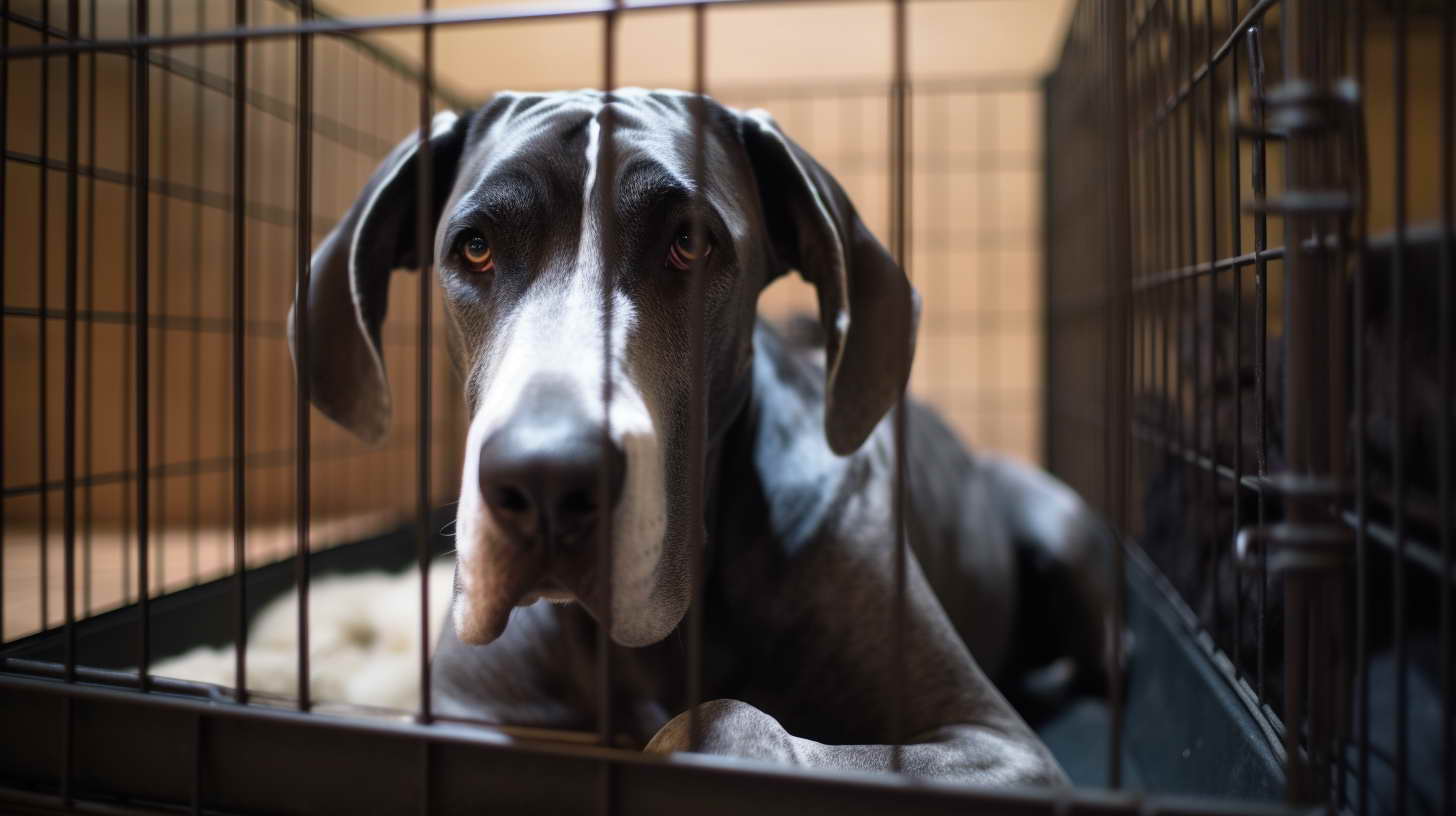
Choosing Appropriate Crate Dimensions For Adult Great Danes
Selecting the right size crate for an adult Great Dane involves measuring your dog and choosing appropriate dimensions. Follow these steps:
- Measure their length – From tip of nose to base of tail while standing, sitting, and lying down fully extended.
- Measure their height – From the floor to the top of their head/ears.
- Measure their width – Across their widest point (usually the ribs/chest area).
- Add at least 4-6 inches to their length measurement for the crate length.
- Choose a width that allows them to lay on their side without feeling cramped.
- Select a height that allows them to stand fully upright.
- Consider sizing up for very large or giant Great Danes over 150 lbs.
- Look for XXL crates designed specifically for giant breeds if needed.
- Get a crate with adjustable sizing or divider panels to customize the interior space.
- Focus on heavy-duty crates that can withstand scratching or escape attempts.
Following these guidelines ensures you choose a properly sized crate for your adult Great Dane based on their unique measurements and needs. Oversized crates allow them to stand, stretch out, and turn freely.
Crate Training Advice For Adult Great Danes
If you’ve adopted an adult Great Dane that’s not crate-trained, follow these tips:
- Start by feeding them in the open crate to build positive associations.
- Place a comfy blanket and favorite toys inside to make it more welcoming.
- Keep initial crate times very short, starting with just 10-15 minutes.
- Use treats and praise to reward calm behavior in the crate.
- Practice basic crate training commands like “kennel up” and “settle”.
- Tire them out first with exercise – a tired dog is more likely to rest quietly.
- Use background noise like music or TV to muffle outside sounds.
- Never use the crate for punishment or unwanted confinement.
- Gradually work up to longer durations in the crate as they adjust.
With time and positive reinforcement, adult Great Danes can learn to see their crate as a relaxing sanctuary. Proper training prevents anxiety or vocal objections.
Daily Crate Time Limits For Great Danes
While crates provide valuable containment and house-training benefits, they should not be over-used. Follow these general time limit guidelines for Great Danes:
- 8-12 Week Puppies – 1 hour maximum, with potty breaks every 2 hours
- 3-6 Month Puppies – 3 hours maximum, with potty breaks every 4 hours
- 6-18 Month Puppies – 4-5 hours maximum, with potty breaks every 6 hours
- Adult Dogs (1-7 Years) – 6-8 hours maximum
- Senior Dogs (8+ Years) – 4-6 hours maximum
Try to arrange your schedule so your Great Dane is not crated for longer than these recommended periods. Puppies under 1 year especially should not be confined for extended stretches. Make sure every dog gets sufficient exercise and interaction when not crated.
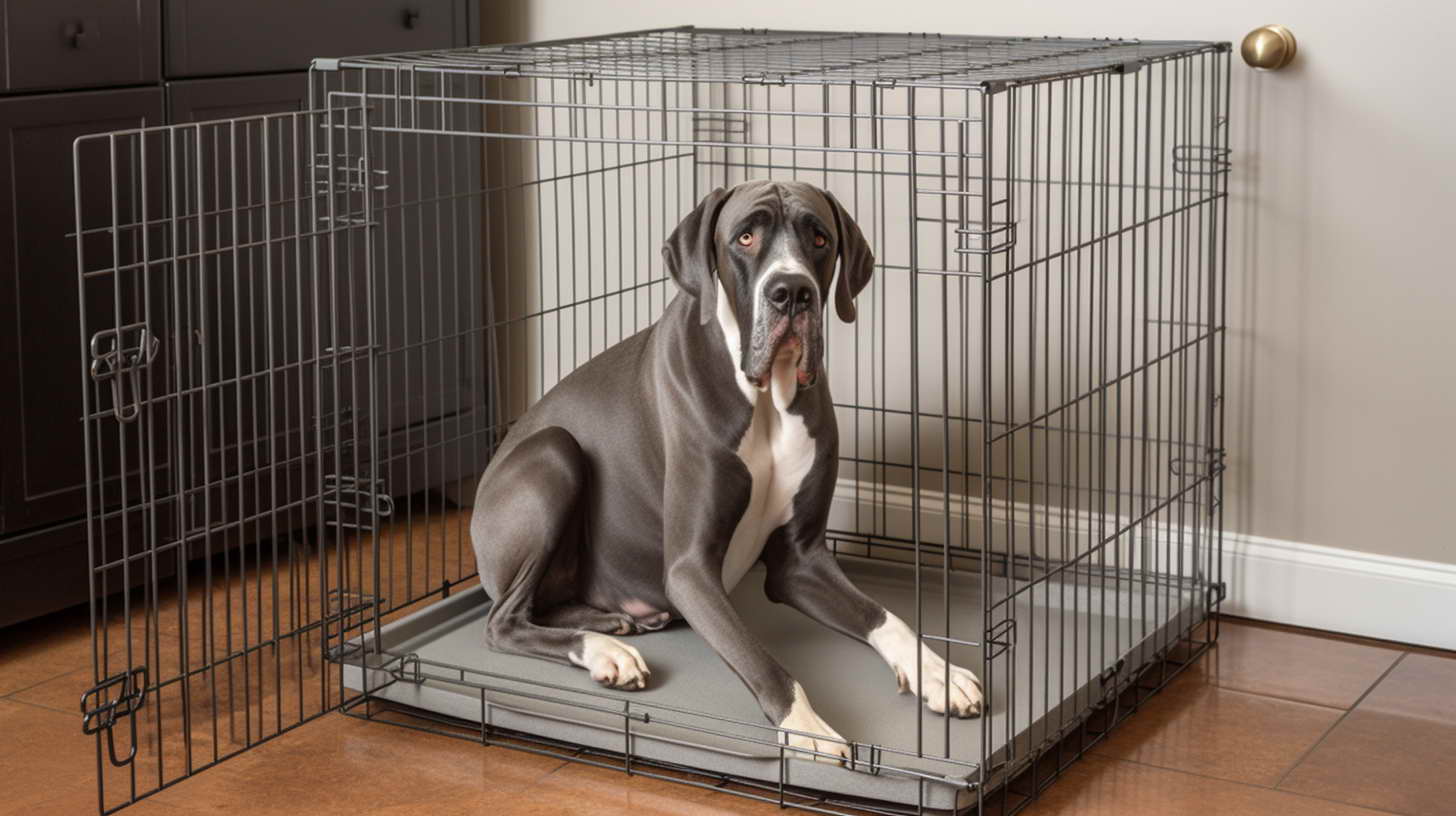
Crate Alternatives For Managing Large Breed Dogs
Crates provide safe, confined spaces for controlling destructive dogs, but they aren’t the only option. Consider these crate alternatives for managing your Great Dane:
- Baby gates – Limit access to certain rooms or block off doorways.
- Dog runs – Outdoor kennels allow fresh air and more space.
- Dog-proofed room – Designate a “safe” room with no chewing hazards.
- Playpens – Portable fabric pens can enclose an exercise area.
- Tethers – Keep dogs attached via leash to sturdy anchors.
- Doggy daycare – Drop off at a reputable facility when you’ll be away.
With training and proper precautions, confining giant breeds doesn’t always require crating. However, most experts still recommend crate training as it provides security, consistency, and cleanliness benefits.
Choosing Crates For Great Dane Puppies, Adults & Seniors
The optimal crate for your Great Dane depends on their age and needs:
Puppies – Look for crates with dividers, leak-proof trays, easy cleaning and portability. Prioritize adjustability to accommodate rapid growth.
Adults – Focus on extra-large and XXL crates designed for giant breeds that are durable, secure, and well-ventilated. Opt for heavy-duty materials.
Seniors – Choose accessible crates with low entry points. Add thick orthopedic bedding for joint support. Utilize shorter periods and more frequent potty breaks.
Your crate selection should adapt over your Great Dane’s life stages. As a puppy transitions to an adult, size up accordingly. Adjust confinement times to match their age, bladder control, and activity levels.
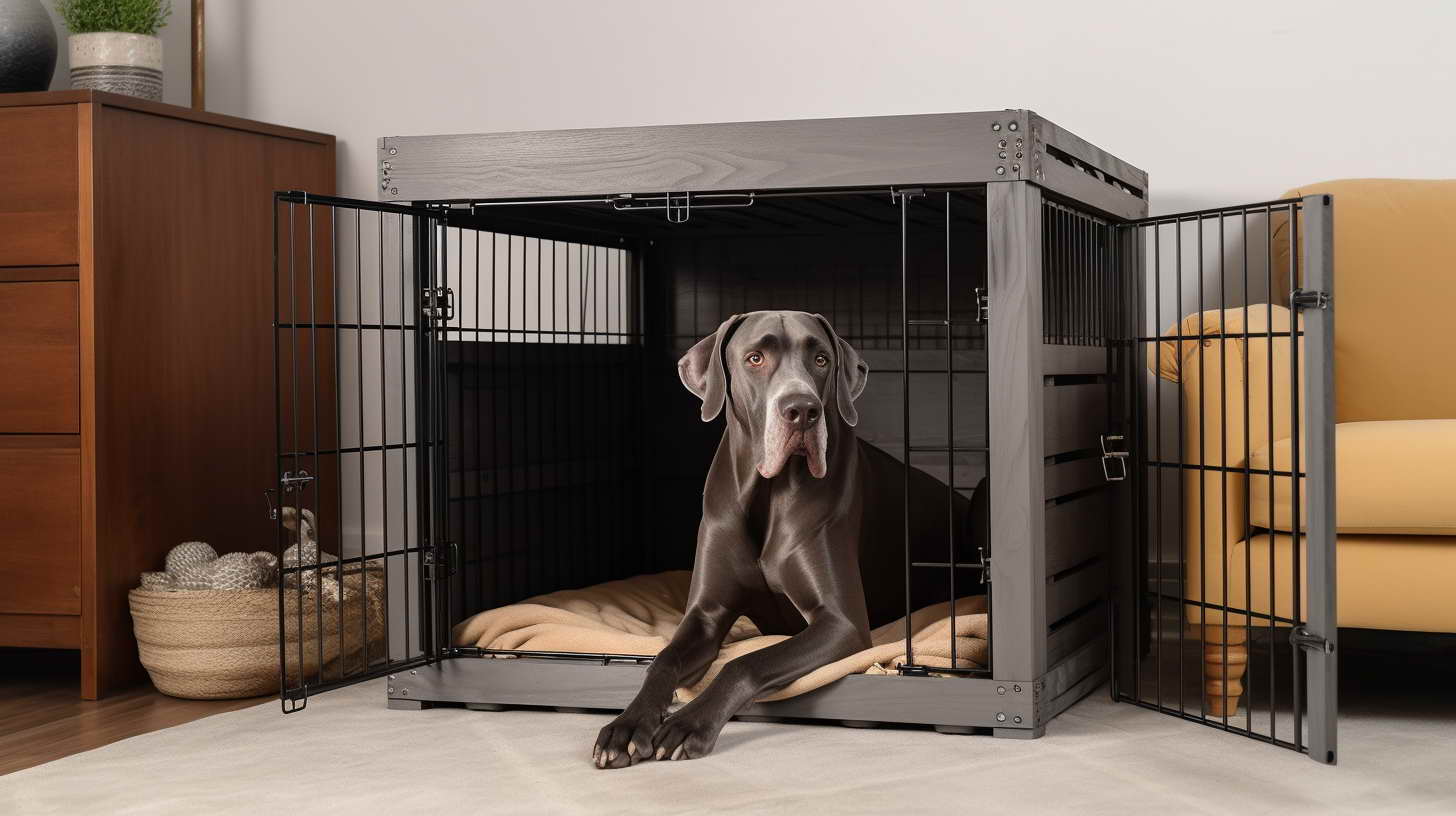
Adding Beds & Accessories To Great Dane Crates
While most crates come bare, adding soft bedding and accessories can increase your Great Dane’s comfort and happiness inside. Consider including:
- Orthopedic dog beds – Provide padding and joint support. Look for chew-resistant, easy-clean options.
- Crate mats – Affordable, durable pads and mats to cushion hard floors.
- Chew toys – Durable rubber chew toys help relieve boredom and anxiety.
- Treats or meals – Feeding your dog in their crate builds positive associations. Use puzzle toys for mental stimulation.
- Anxiety wraps – These specialized wraps gently hug and calm anxious or stressed dogs.
Customizing your Great Dane’s crate makes it more welcoming. Introduce new beds and toys gradually to avoid resource guarding. Remove collars before crating to prevent choking hazards.
Cleaning & Maintenance Tips For Oversized Dog Crates
Maintaining a clean, well-functioning crate is important, especially for giant breeds. Follow these upkeep tips:
- Wash removable crate trays, mats, and bedding frequently.
- Use pet-safe disinfectants inside the crate to kill germs.
- Inspect for damage like broken wires or latches and repair immediately.
- Tighten any loose screws or connection points on wire crates.
- Vacuum or wipe out hair, dirt, and debris with cleaners.
- Make sure ventilation holes or slats aren’t obstructed.
- Consider replacing crates after many years due to wear and tear.
- Scrub, hose, or pressure wash outdoor kennels and run periodically.
Regular crate cleaning and maintenance keep your Great Dane healthy and prevent environmental stressors like odor buildup.
Traveling With A Crate-Trained Great Dane
The portability of wire, plastic, and fabric crates makes them ideal for trips with a Great Dane in tow. When traveling:
- Measure space in your vehicle to ensure the crate fits and secures safely.
- Plan for stops every 2-4 hours to let puppies potty and stretch.
- Bring along food, water, medications, cleanup supplies, chew toys, and familiar bedding.
- Place a blanket over the crate to block outside sights and sounds.
- Use pheromone sprays or anxiety wraps to ease nervousness.
- Properly ID your crate and dog with your contact information.
- Request ground floor rooms for easy crate access at hotels or lodgings.
With the right planning and accessories, crate-trained Great Danes can travel almost anywhere their people go! Proper identification and safety precautions are essential when crate training on the road.
Great Dane Housetraining Setbacks and Prevention
Even well-trained adult Great Danes can occasionally have accidents or regress in their housetraining. If your fully housebroken Great Dane begins having frequent accidents, possible causes include:
- Illness or disease – Urinary infections, diabetes, kidney disease, and other conditions can cause incontinence. Have your vet check for medical issues.
- Stress – Changes in environment or routine, anxiety, new people, or loud noises can induce marking or inappropriate elimination.
- Inadequate exercise – Insufficient walks and playtime can lead to pent-up energy and accidents. Stick to a regular exercise schedule.
- Confusion – Advanced age can result in occasional lapses in housetraining. Be patient and calmly return outside.
- Change in mobility – Arthritis pain or limited mobility can make it difficult to hold urine or reach the outdoors. Consider doggy diapers or pee pads.
- Incomplete training – Some dogs are never fully housetrained if mistakes are not properly corrected from puppyhood. Go back to basics with positive reinforcement.
Patience, routine, and vet checks are key to resolving housetraining regressions in adult Great Danes. Thoroughly clean all accident sites and reinforce appropriate potty habits.
Tips For Housetraining An Adopted Great Dane
Adopted adult Great Danes often require re-training or extensive housetraining. Use these tips if adopting an untrained dog:
- Establish a predictable feeding and potty routine. Take outside immediately after meals, naps, playtime, and every 2-4 hours.
- Praise and reward with treats whenever they eliminate in the right spot outside.
- Limit access inside the home until fully housebroken. Use baby gates, crates, tethers, and leashes to restrict unsupervised roaming.
- Watch for circling, sniffing, squatting, or other potty signals. Immediately interrupt and escort outside.
- Use enzyme-based cleaners to fully eliminate odors from any indoor accidents. Dogs are drawn back to smell.
- Be extremely patient and consistent. It can take weeks or months to re-train adult dogs.
- Seek help from an experienced trainer or behaviorist for difficult cases of submissive/excited urination.
- Schedule a vet visit to rule out underlying medical conditions causing accidents.
- Avoid punishment like yelling or rubbing your nose in urine, which will worsen anxiety and make training harder.
With time, positive reinforcement, and veterinary guidance, adopted adult Great Danes can overcome potty training challenges. Maintain realistic expectations for the training timeline based on their unique history and temperament.
Crate Training An Adopted Adult Great Dane
For adopted Great Danes that are not accustomed to crates, introduce training slowly using these techniques:
- Set up the crate in a low-traffic room with familiar scents and bedding inside. Leave the door open at first.
- Encourage voluntary crate exploration and rest by dropping treats and toys near and inside the entrance.
- Begin feeding meals inside the crate with the door open to build positive associations.
- Use “kennel up” and “crate” commands paired with treats to direct your dog inside. Employ a happy tone – not force.
- Keep initial crate times very brief – just 10-15 minutes – so confinement doesn’t feel scary or punitive.
- Use food puzzles, chews, and calming music to make creating sessions pleasant and distracting.
- If your dog vocalizes or tries to escape, wait until they are quiet to let them out.
- Very gradually increase crate duration over many weeks as they gain comfort and confidence.
Proper introductions to crating allow newly adopted Great Danes to adjust at their own pace. Their past experiences may make training more challenging, so remain patient and encouraging through struggles.
Crate Training A Rescue Great Dane
Rescue Great Danes may come with an unknown history that results in fear or aversion toward crates and confinement. Use these gentle techniques when crate training:
- Evaluate their initial reaction to the crate and work at a very gradual pace if they are highly fearful.
- Toss treats around and into the crate until they readily enter/exit on their own to eat them.
- Begin by simply feeding them near and eventually inside the open crate.
- Encourage rest near the crate with praise and gentle pets. Never force them inside.
- If they struggle with the crate door closed, return to previous steps leaving it open for many more sessions.
- Introduce an anxiety shirt or pheromone diffuser to reduce stress during early training.
- Keep sessions extremely short at first – 30 seconds to 2 minutes inside – and end on a positive note.
- Use high-value food like chicken or cheese to distract and reward during crating time.
With rescued Danes, the crate training process may take weeks or months. Let their comfort level determine the pace, not any set timeframe. If severe anxiety persists, consult a certified trainer or behaviorist for guidance.
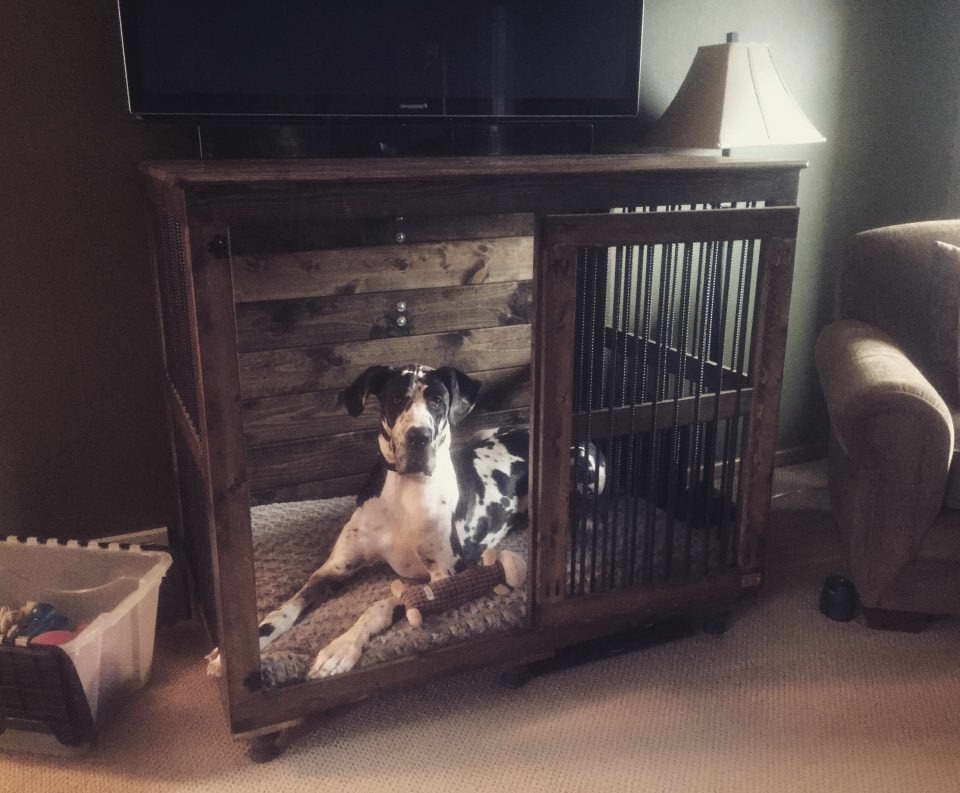
Troubleshooting: Great Dane Has Accidents in the Crate
If your previously housebroken Great Dane suddenly begins soiling their crate, possible causes include:
- Illness – Bladder infections, kidney disease, or diabetes can cause incontinence. Have your vet run tests.
- Poor crate sizing – If the crate is too large, they may use one end as a bathroom. Size down if needed.
- Excessive crate time – Holding it too long between potty breaks can lead to accidents. Stick to recommended time limits.
- Stress – Changes in routine, environment, travel, loud noises, or new people could induce marking. Minimize stressors when crated.
- Submissive urination – Some dogs, especially untrained rescues, have urine marks or pee submissively in the crate. Use positive reinforcement to build confidence.
Thoroughly clean all accidents with enzymatic cleaner. Rule out medical issues with your veterinarian. Consider scaling back freedom and access if marking behavior persists.
Keeping Great Danes Safe When Left Alone or Crated
There are several precautions to take when leaving your Great Dane home alone or crated:
- Remove collars and leashes that could snag and create choking or strangulation hazards.
- Ensure they have fresh, cool drinking water available, especially on hot days. Use no-spill bowls.
- Avoid leaving new, dangerous chew items like rawhides that could cause choking or digestive issues. Stick to durable rubber chews instead.
- Check that all doors, gates, and crate latches are securely fastened so they cannot be pushed open.
- Make sure any other household pets have their confined areas.
- Place crates and gates where they are protected from electrical cords, chemicals, and other potential hazards.
- Never crate on an unprotected porch or patio where they are exposed to weather extremes or predators.
Taking proper precautions allows you to crate and leave your Great Dane worry-free. Always prioritize safety, comfort, and adequate supervision when confining large dogs.
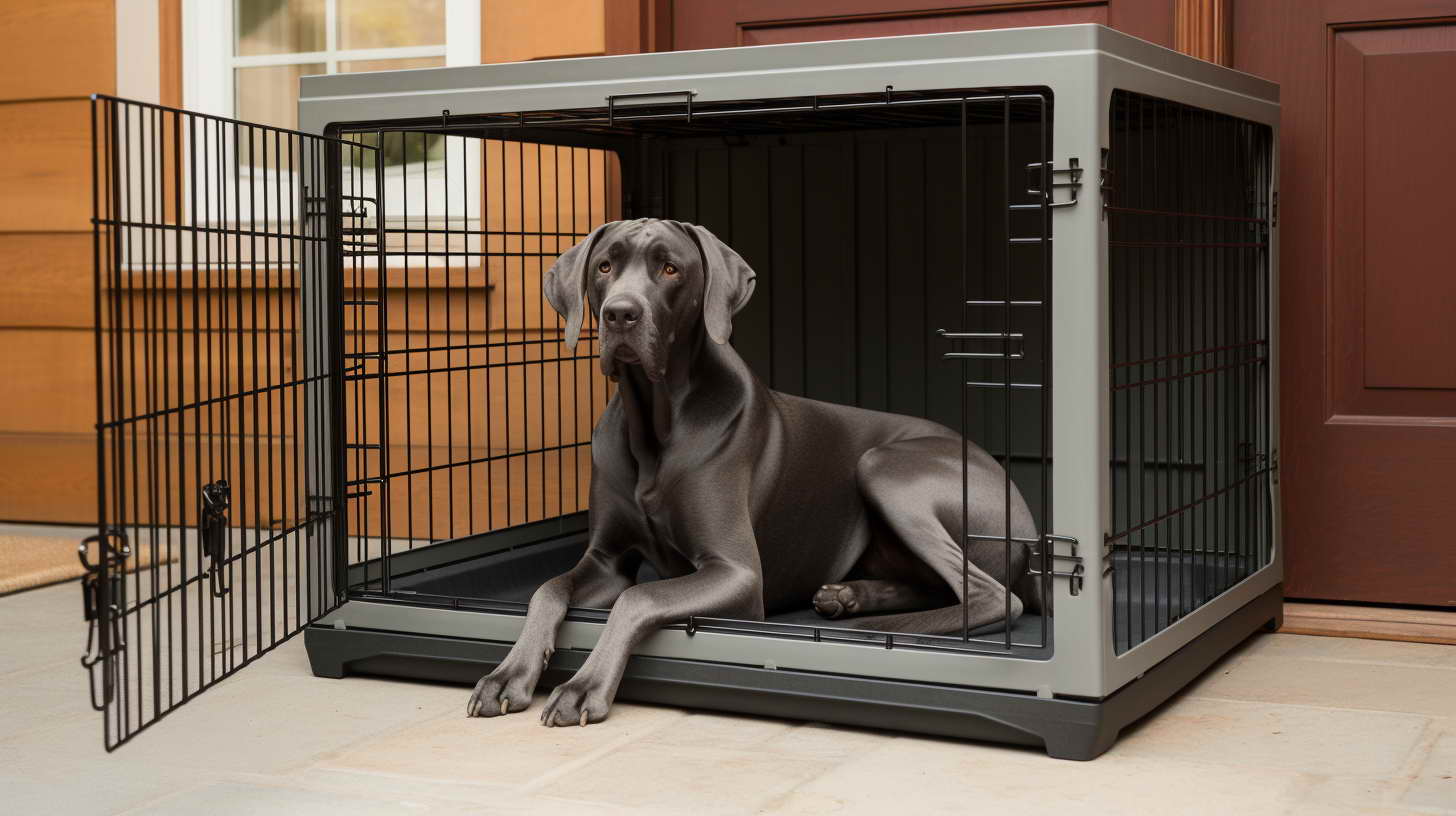
Great Dane Crate Training Schedule Example
A sample crate training schedule for an 8-week-old Great Dane puppy may look like this:
- 6:00 am – Let the puppy out to potty immediately after waking up. Feed breakfast in a crate with the door open.
- 7:00 am – Naptime. Place in a crate with a chew toy for 1 hour.
- 8:00 am – Potty break outside. Free play.
- 10:00 am – Down for a nap in crate for 2 hours.
- Noon – Let the puppy out to potty. Playtime. Feed lunch in the crate.
- 1:00 pm – Limit water. Naptime crated for 2 hours.
- 3:00 pm – Take outside to potty. Supervised playtime.
- 5:00 pm – Feed dinner in crate.
- 6:00 pm – Potty break then naptime in crate for 2 hours.
- 8:00 pm – Playtime followed by a final potty break.
- 10:00 pm – Lights out in crate overnight.
This schedule ensures adequate crate acclimation, play, and potty time for housetraining. The durations can increase gradually as your Great Dane puppy matures.
Signs It’s Time to Transition to a Larger Crate
As your Great Dane puppy grows, you’ll need to size up their crate periodically to ensure comfort. Signs it’s time to transition to a larger crate include:
- Your puppy’s length makes it difficult for them to lay down fully.
- Their head touches the ceiling when standing fully upright.
- They must scrunch or hunch to sit, stand, or turn around.
- Accidents start occurring due to lack of space.
- The weight guidelines for that crate size have been exceeded.
- Your puppy starts chewing, bending, or damaging crate wires due to frustration.
- There is not enough length to divide the crate for potty training needs.
Do not prolong transitioning to a larger crate size. As soon as your Great Dane pup appears cramped or distressed in their current space, move them to more spacious, comfortable accommodations.
Great Dane Crate Training Do’s and Don’ts
When crate training a Great Dane puppy or adult dog, follow these dos and don’ts:
DO:
- Make the crate comfortable with bedding and chew toys
- Use positive reinforcement and treats for training
- Establish a predictable routine for creating
- Provide exercise, playtime, and affection outside the crate
- Be patient – crate training takes days or weeks
- Clean messes immediately with an enzyme cleaner
DON’T:
- Use the crate for punishment or unwanted confinement
- Crate for excessively long periods
- Force an anxious dog into the crate
- Place the crate in a busy, noisy area
- Remove collar/leash/harness while inside – choking hazard
Following these simple guidelines will make crate training pleasant and effective for both you and your Great Dane. The crate should be a refuge.
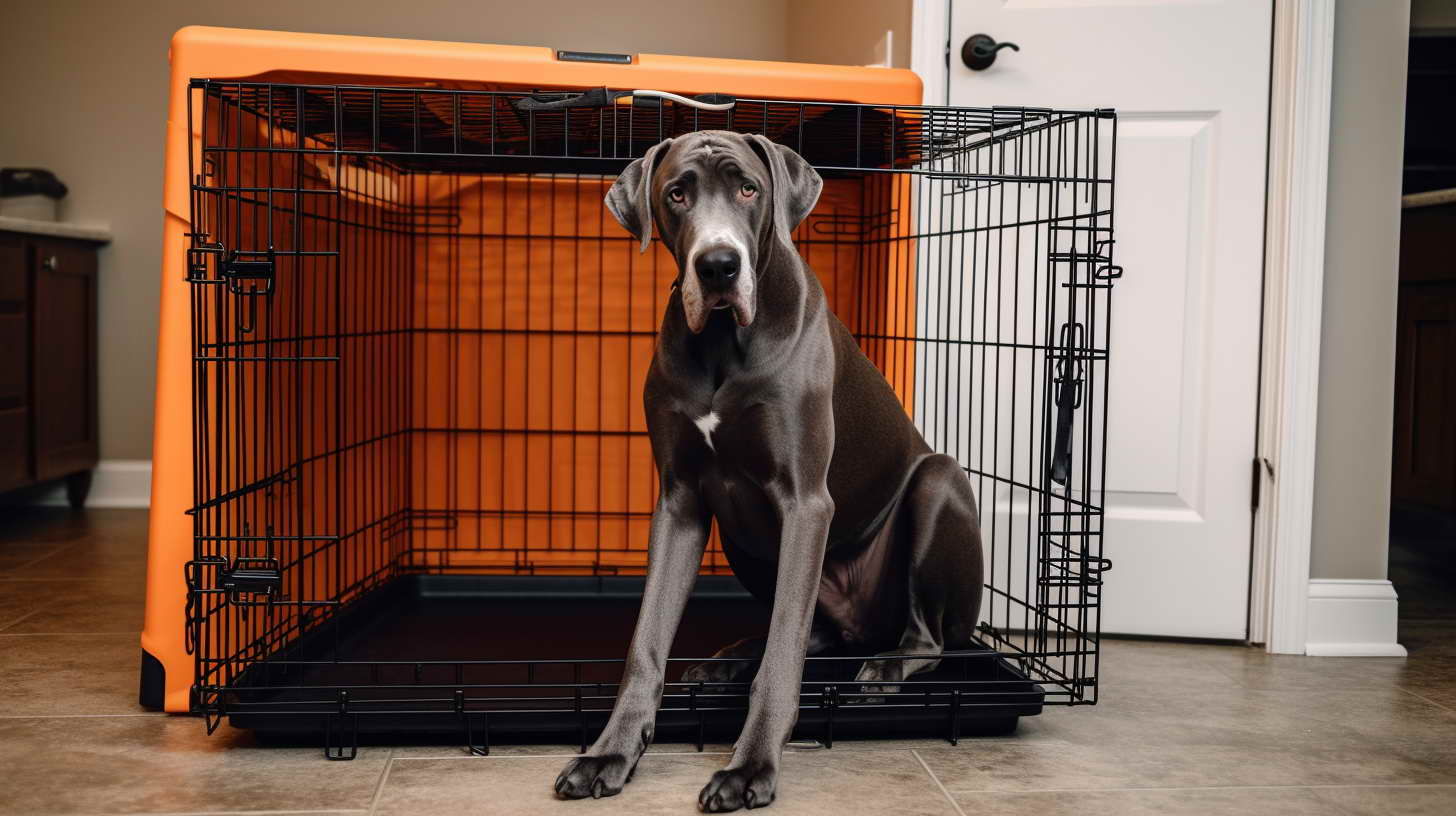
Great Dane Crate Training Schedule By Age
Crate training timeframes should follow age-appropriate guidelines. Here are suggested schedules for Great Danes at different life stages:
8-12 Week Puppy
- 1-2 hours crated, with potty breaks every 2 hours
- Nap created after meals, playtime, and potty time
- Nighttime crate overnight
3-6 Month Puppy
- 2-3 hours crated, with potty breaks every 3-4 hours
- Nap created after meals, playtime, and potty time
- Nighttime crate overnight
6-18 Month Puppy
- 3-5 hours crated, with potty breaks every 4-6 hours
- Nap created after meals, playtime, and potty time
- Nighttime crate overnight
1-7 Year Adult
- 6-8 hours crated, with outdoor breaks every 6-8 hours
- Crate when unsupervised for safety and prevention of destructive behavior
- Nighttime crate overnight
8+ Year Senior
- 4-6 hours created, with more frequent outdoor breaks
- Crate when unsupervised for safety and prevention of destructive behavior
- Nighttime crate overnight
Adjust crating duration based on age, bladder control, and health status. Puppies require much more frequent breaks than adult dogs. Seniors may regress and need more daytime trips outside.
Conclusion
From dynamic puppy to massive adult, selecting the right sized crate is crucial at every stage of a Great Dane’s life. Allowing enough room for standing, stretching out, and turning around keeps your dog comfortable and content. Heavy-duty XXL crates designed for giant breeds provide the spaciousness this colossal canine needs. With the proper crate training techniques, even reluctant or rescued Danes can come to appreciate their crate as a relaxing den. Regular maintenance and cleaning make the crate an inviting, odor-free space your dog will seek out on their own. While crating requires care and caution, when done right it provides invaluable benefits for both Great Dane and owner alike.

Leave a Reply